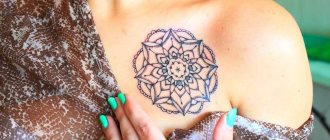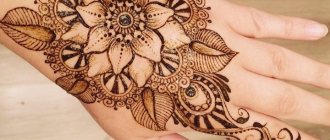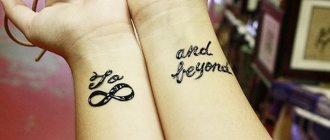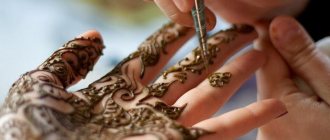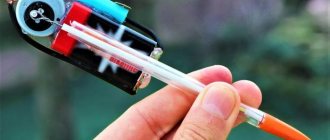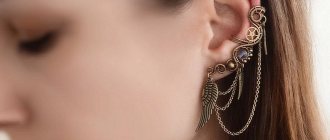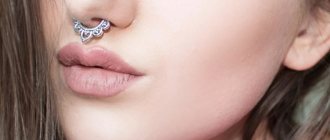Danger of tattooing at home
Most often to the category of "at-home" refer novice masters who do not have their own portfolio, experience, accumulated clientele. Among them there can be talented tattoo artists, but it is difficult to determine the degree of skill because they can give photos of other people's works as an example.
Another dangerous point is ignoring hygienic rules. Most often such "masters" do not have the means to effectively sterilize their tools, which is fraught with very unpleasant health consequences for clients.
Sterility factor
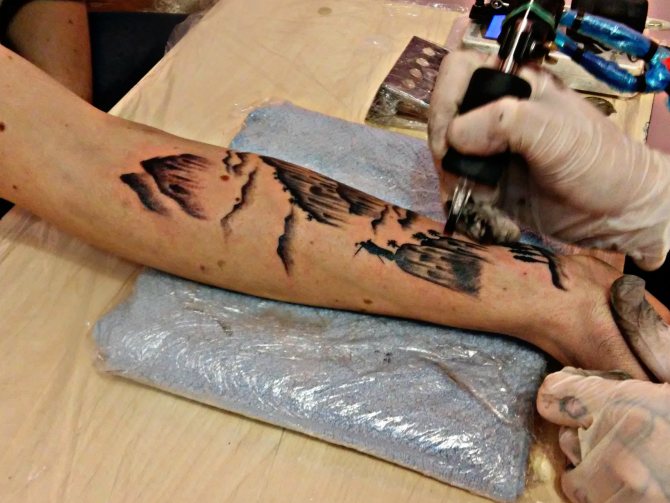
Approximately 90% of salons attach great importance to sterility of tools and the entire salon. After all, salons are often checked by employees of the Sanitary and Epidemiological Service. And also because if the client is infected, he can sue the organization.
If we talk about home masters, many of them make a lot of mistakes:
- do not pay attention to sterility;
- pour the paint after the client back into the bottle;
- do not use a barrier;
- and some individuals even ignore gloves.
And the most terrible is that to such home masters people go and they get tattoos with spilled paints, dirty needles, on the sofa where the cat was walking along the street.
Therefore, if you go to the home master, make sure that he sterilizes the tools, the workplace and responsibly treats the health of each client.
Probable Consequences of Applying a Tattoo at Home
Visiting a master "at-home" can cause a number of serious problems. Among them:
- Getting an infectious disease due to the lack of disinfecting equipment, disposable consumables, failure to follow hygienic rules when preparing the workplace.
- Poor quality of the applied body art. In cases of the client's illness or unsatisfactory result of the work, such master does not bear any responsibility, because he has no official registration.
- Lack of accompaniment after tattooing. "Homemaker" may refuse to correct the figure or solve other problems that arise during the period of its healing. He may not answer the phone and avoid meetings in every possible way.
- The client is likely to be stressed out due to inappropriate working conditions.
At home or in the salon?
There are, however, differences. In specialized studios or salons, the room is adapted to the necessary sanitary conditions. The floor, from which it is easy to remove dirt and quickly wipe with a disinfectant solution. Special containers for waste and needles. Custom-made furniture for the comfort of the client when working in different positions.
But this is all necessary, as different clients go through the studio and possibly have health problems.
At home, sterilization of the tools, restriction with the surface on which the session will be held (you don't want to smear everything around for memory), and personal hygiene of the master and the client are important.
All the necessary things for the drawing procedure should be with the tattooist, if the tattoo is done at the client's home or at the master's apartment.
Advantages of going to a tattoo salon with a good reputation
Doubtful economy from visiting the tattoo "at-home" can be completely destroyed by the necessity to restore health or to cover up a bad tattoo. All these troubles can be avoided, if at once to address in the tattoo-salon with good reputation, real positive responses, an extensive clientele.
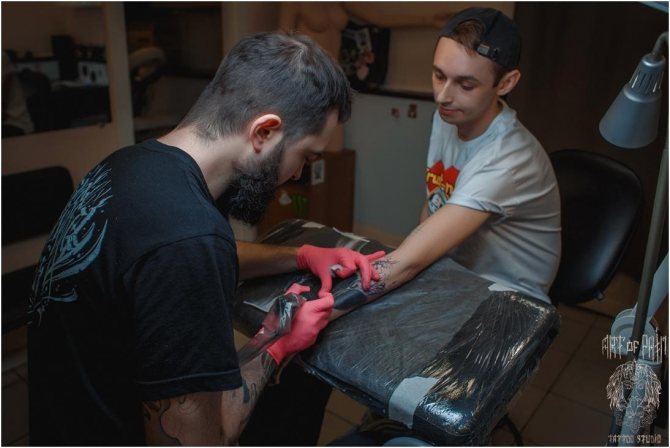

The advantages of this solution:
- Only qualified masters with a real portfolio work in the staff of a self-respecting studio.
- Tattoo salon has an official work permit, and compliance of its conditions with sanitary and hygienic standards is confirmed by certificates and other approvals.
- The salon is fully responsible for the health of its clients, so the tattooing and piercing procedure is completely safe here.
- Masters tattoo parlor value their clients and their reputation, that is why they do their best to receive high quality results.
Officially working tattoo studios do not hide the rules and conditions of the sessions, they provide permits, information about the employees and the methods of disinfection.
Seven Safe Ways to Get a Temporary Tattoo at Home
A temporary tattoo can be done at home. There are at least 7 popular ways in which in a couple of minutes you can become a tattoo owner. All methods are simple, you can make such tattoos even by yourself.
Way 1: by means of a stencil


If you don't rely on your own drawing skills, it is better to use a stencil. Made well, such tattoos look as if a professional worked on them.
Buy permanent markers in advance. Black is the base color, but if you want, you can add bright colors and buy a couple more colored markers.
Not all colored markers are meant to be used on skin. Find ones that won't harm your skin.
Procedure:
- Place the stencil on the part of the body where the tattoo will be. Hold the stencil firmly with one hand, and use the other hand to fill in the gaps with a permanent marker.
- Remove the stencil and let the ink dry completely.
When you get bored with the tattoo, you can easily wash it off with soap and warm water.
Method 2: Using an eye pencil


Getting a tattoo with an eye pencil is not difficult. To do this, you first need to go to a store and choose a soft eye pencil, but one that is sharpenable. Practice drawing on paper, sketch patterns.
A tattoo done with a pencil will look better if it's simple clear lines (as in tattoo sketches). Small complex patterns will be difficult to draw, and in addition, they will be blurred.
Procedure:
- Draw a picture of your choice on your hand. It would be better if in front of your eyes will be a sketch. Make sure you get the effect you want. If not, wash the pencil and draw the tattoo again.
- If the drawing needs to be partially shaded or shadowed, use a cotton pad.
- Apply hairspray on top of the tattoo. This will fix the tattoo and help it last at least a day.
- In the evening, it is better to wash off the drawing, so as not to stain clothes and sheets. If desired, the next day draw another.
Such a tattoo is easily washed away with soap and warm water. It is better to use a pencil rather than eyeliner. Liquid eyeliners are good to draw arrows on the eyelid, but to make a quality drawing on the body will not work, as it will spread.
Method 3: Using temporary tattoo paper


Transferable tattoos are loved by children and teens as well as adults. They often look just like the real thing. But not everyone knows that such tattoos can be done at home.
To make transferable tattoos at home, you need to buy special paper. It is a self-adhesive film on a paper base. You can buy it in online stores or in stores with products for needlework.
Beforehand, choose a design for your temporary tattoo. A graphic editor or regular Photoshop will help you with this. If you have a color printer, you can choose a color design. Choose the colors that look best on your skin.
Also, don't forget that you're going to mirror the tattoo. If it has a word on it, it should be written backwards.
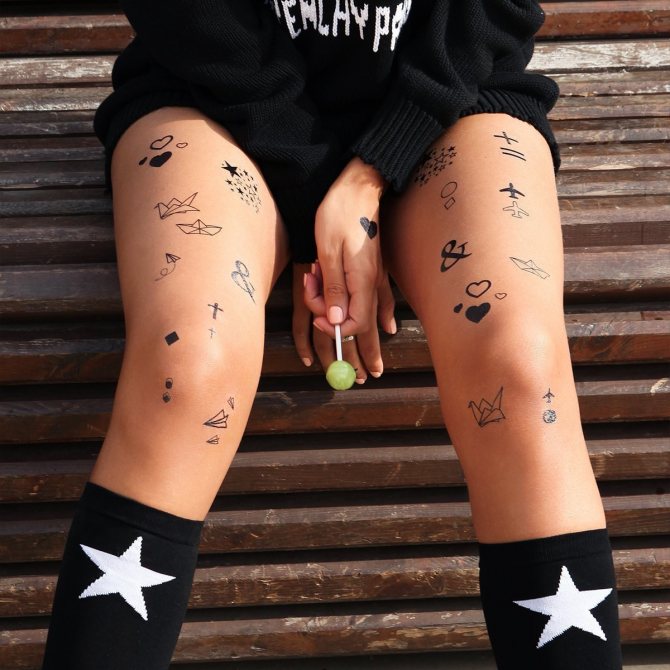

Procedure:
- Paper for a transferable tattoo is placed in the printer. Cut out the printed design with scissors.
- The paper side with the ink applied to the selected spot for the tattoo. Press the tattoo down with a rag, but be careful not to move the design.
- After a minute, remove the rag and paper. The tattoo should be perfectly imprinted on your skin. If it doesn't, don't put it back on. It is better to get a new tattoo.
The tattoo will last about 7 days, after which it will begin to slip and come off in pieces. If the tattoo needs to be removed before one week, soap, hot water and a stiff brush will be required. The tattoo must be scrubbed until it is all gone.
Method 4: with a permanent marker
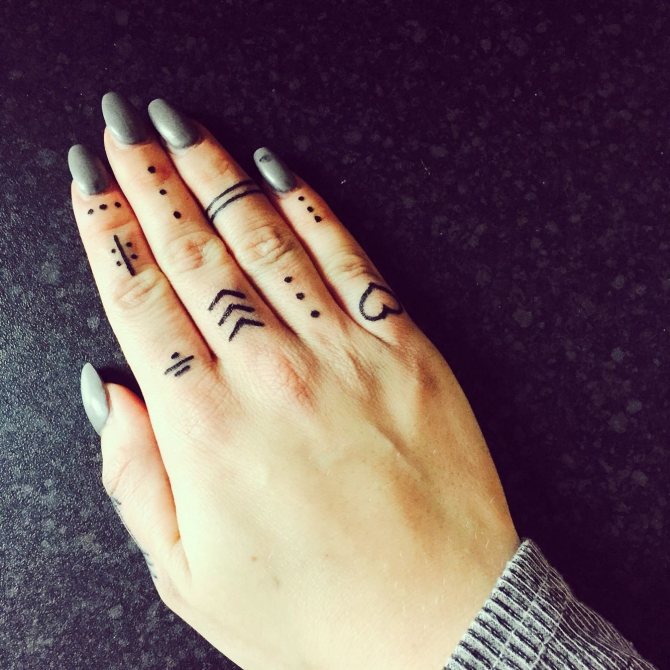

To do a tattoo with a permanent marker, you need to buy hairspray, baby powder and a Sharpie marker. Thanks to the sharp end of the marker, it is very convenient to draw, you can draw even small details.
Procedure:
- Draw any desired pattern anywhere with the marker. Allow the marker to dry for a few seconds.
- Sprinkle baby powder over the tattoo and gently rub it in. Shake off any remaining powder.
- Spray some hairspray on the tattoo and allow to dry. Don't apply too much varnish or you will dry out the skin.
Enjoy your new tattoo. It will last about 30 days. It can always be renewed, or completely washed off and applied a new one.
Method 5: henna tattoos
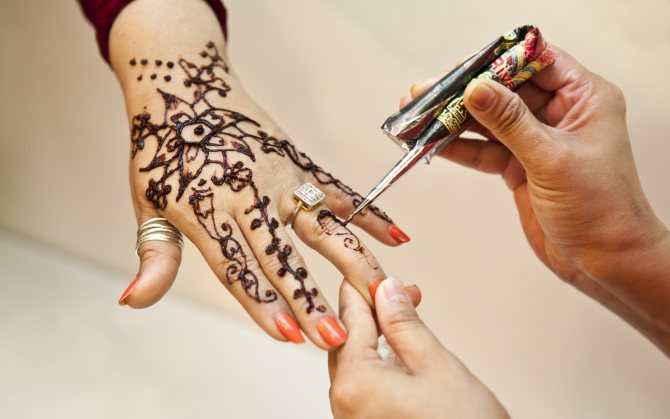

Henna drawings are rightly called biotattoos. They are not harmful to health, unless the person has an individual intolerance to the ingredients used.
It is not necessary to go to the salon in order to get a beautiful henna tattoo. It is enough to buy a few materials, and you can decorate your body yourself, even without the help of a stranger.
The necessary materials:
- henna in the form of powder;
- water;
- A henna cone (you can use a regular syringe without a needle);
- lemon juice and eucalyptus oil;
- stencils and details for the drawing.
Biotattoos are in such demand for the reason that not all people dare to apply a permanent tattoo. A temporary design helps to see how the tattoo will look.
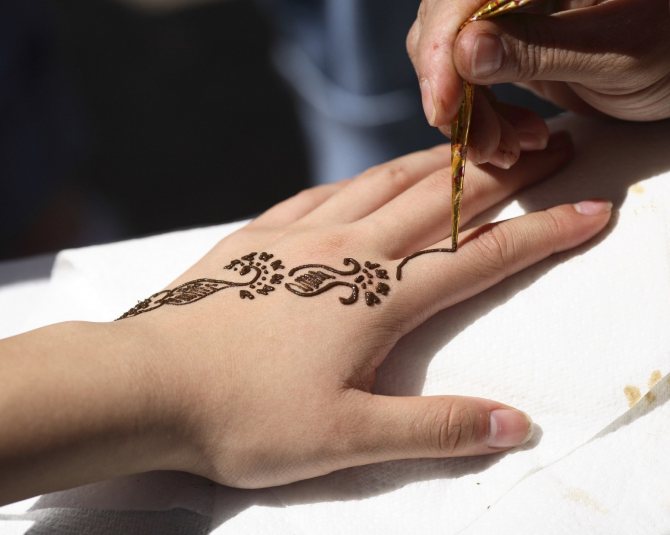

The process of applying a henna tattoo at home:
- Deciding on a pattern. Theoretically, you can draw anything, but there are already blanks for henna tattoos, which are easier to use. If you cannot draw a beautiful pattern, it is better to prepare stencils.
- Prepare the paint. In a separate bowl, mix henna powder, warm water, a little lemon juice. Stir the ingredients until a homogeneous pulp is formed. If you want to make the paint thicker and darker, add a little coffee.
- Prepare the skin on which the drawing will be applied. Lubricate it with eucalyptus oil. This will make the color brighter and help it lay more evenly.
- Draw the pattern on the skin, use a stencil or transfer the pattern to the skin. Start squeezing the paint on top of the drawing. Apply paint from the far corner so you don't smudge it in the process. Do not squeeze too hard or apply more paint than necessary so it won't drip.
- Allow the paint to dry for 40-60 minutes. After that, shake off any residue.
If the drawing was made for a specific event, you can apply hairspray on top of the tattoo. After a few hours, wash off the hairspray and apply cream to the skin.
On average, a henna tattoo will last about 2 to 3 weeks. Do not try to remove the paint sooner, as it absorbs very well. It is better to wait until it comes off on its own.
If you want to repeat the tattoo, it is advisable to choose another area on the body. Repeated biotattoos in the same area will dry out your skin and cause it to age faster.
Method 6: with a gel pen
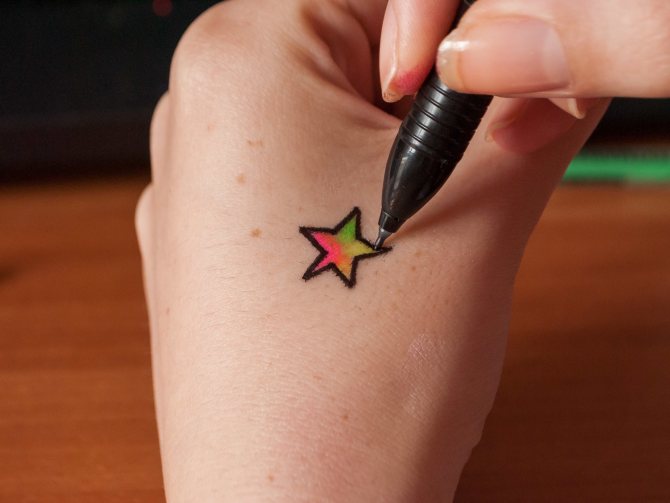

Gel pens can be used for more than just drawing on paper. They are great for making a beautiful temporary tattoo on the body. It is not necessary to know how to draw, you can buy beautiful stencils and use them to draw a tattoo.
Necessary materials:
- a set of gel pens;
- A rag or sponge;
- the liquid on an alcohol basis;
- tracing paper;
- hairspray;
- wax;
- a stencil if you don't know how to draw.
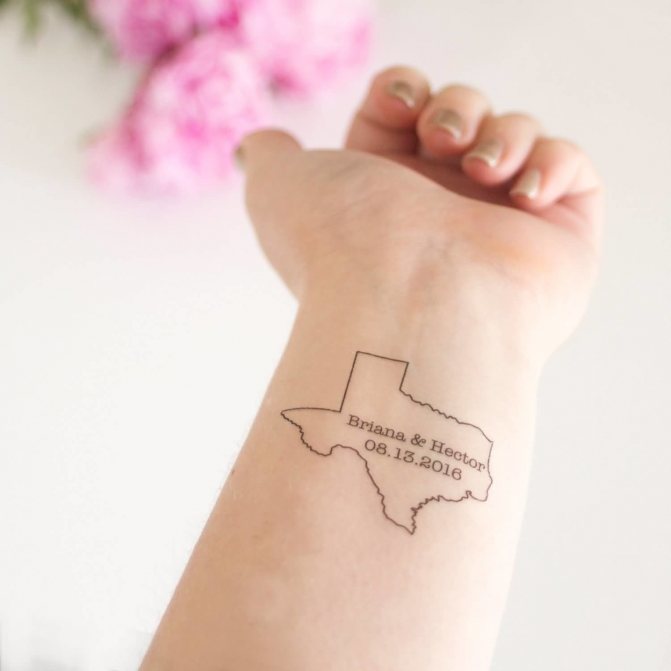

To draw a temporary tattoo with a gel pen, you need to do the following steps:
- Draw a sketch on tracing paper, or use a purchased stencil. Draw the sketch well to get a beautiful tattoo.
- Apply the tracing paper to clean, dry skin. Moisten the paper with a damp cloth or sponge.
- After 3 minutes, remove the tracing paper and draw the resulting tattoo well with a pen.
- Leave the drawing to dry for at least 2 hours. If you notice any extra lines, wipe them off with alcohol.
To fix the resulting pattern, spray some hairspray on it. You should also rub some melted wax from the candle to create an invisible film. This will preserve the quality of the pattern and prolong its shelf life.
Method 7: using a printer and perfume
In order to make a tattoo using a printer and perfume, you mainly need to have a printer and glue paper. It is also important to prepare an alcohol-based liquid, perfume or cologne will do.
Read the full article about how to make a tattoo with a printer and perfume here.
Scheme of homemade tattoo machine
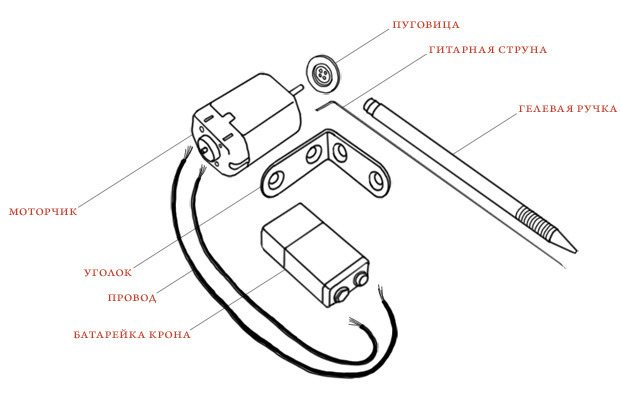

All the specifics of the style stem from the fact that anyone can get a homemade tattoo, which gives them a certain degree of freedom. However, in order for the tattoo to succeed, it is good to have some experience and at least a little design ability. Those who have thought of doing a tattoo themselves, find themselves in a situation where they can do anything, but know practically nothing. The only way out is to choose a simple drawing and make a small tattoo in one color, without using any complicated techniques.
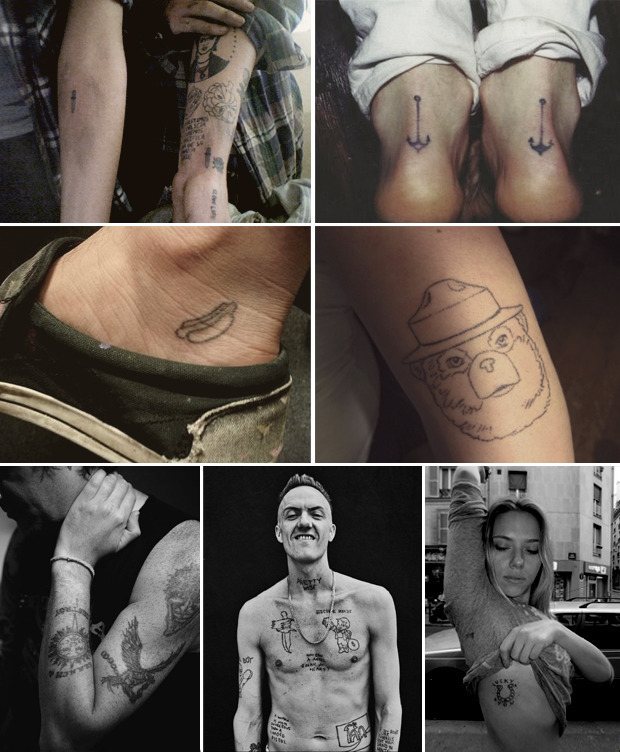

Professionals treat such tattoos with disdain, and one can certainly understand them. At the same time, one cannot deny that home tattoos have a certain charm. Of course, with a professional master you can not worry about the sterility of the needle, shaky hands or the fact that the ink will run out before time. On the other hand, a home tattoo can be more individual and unique than a salon one, and of course it will mean a lot more to you if you do it yourself or ask your friends to do it.
| Vadik Shafakov, lover of home tattoos | "I've always wanted to try to tattoo myself or one of my friends' portacos. The first samples came out crooked, but they don't look so awful as to feel any shame. Now we do small uncomplicated tattoos for friends, the easiest ones are symbols and inscriptions. I've had a lot of tattoos, over time I've learned how to prepare for the process, sterilize the parts and assemble the machine. So far I haven't done much myself: a face, a couple of phrases, a few symbols. The other day I plan to stuff my friend's cat - a beautiful portrait of him. He drew it cool - I'll try to beat it up neatly. We'll do it in the company of beer and hard liquor, so the hand doesn't shake and no one changes their mind. |
First of all, you have to sacrifice the perfect design for the sake of the individual and be prepared for the fact that the end result is absolutely not what you would like to live with (and have to). The result is always a surprise and destiny: predictability is out of the question. The same applies to the tools: there can be no restrictions on technique here, but perhaps the greatest chic in this matter - to make a tattoo-machine itself.
From all this follows that the genre of home-made tattoos by its ideology denies the very possibility of existence of experts in this business. And yet, there are three names in this world that everyone knows (or should know).


The main defender of home tattoos is the Australian artist Thomas Jeppe, who also argues that it is a separate culture. Thomas was the first to reflect on this phenomenon and then wrote the illustrated manifesto Home-made Tattoo Rule. The book features about 90 photographs of various styles of home-made tattooing, from small symbols and texts to fully "scored" bodies. You can also find information here about the inventory, the process, and what each might turn out to be.
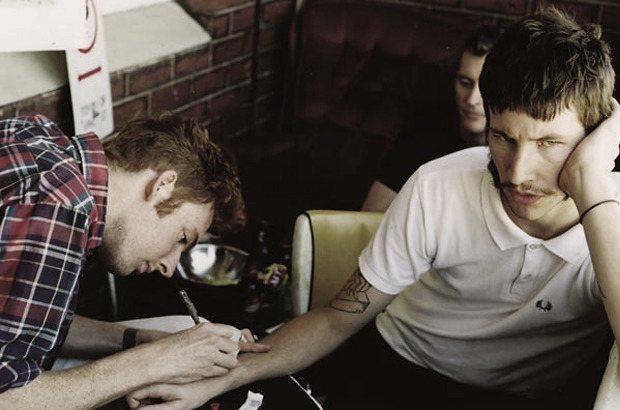

Jeppe himself has been getting homemade tattoos for about three years and treats each one very positively whether or not they turn out well: "I've messed up a lot of my tattoos, but I'm happy with them all. The mistakes make them all the more beloved.


The body of British designer Fergus Purcell remains perhaps the strongest argument of home tattoo lovers in arguments about aesthetics. In any argument about this style, Fergus' hand works as the best argument for it. He's also on the cover of the Home-made Tattoo Rule. Fergus' own favorite tattoo remains the Donatello ninja turtle (pictured below), as well as seven tattoos dedicated to his wife.
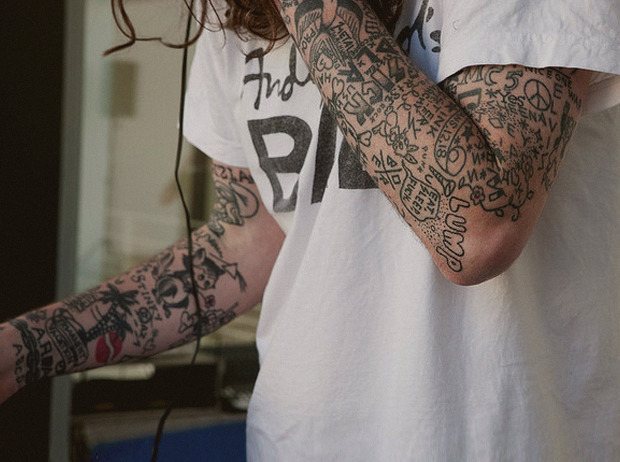

| Fergus Purcell, designer | "I got my first tattoo when I was 21, got a couple more over the next few years, and they were all done by professionals. And then a friend asked me, 'Why don't you have any home tattoos (which I really don't),' and it just clicked in my head. That same night I got one on my wrist and I was hooked. Once I started getting my own tattoos, it became clear to me what they should look like." |
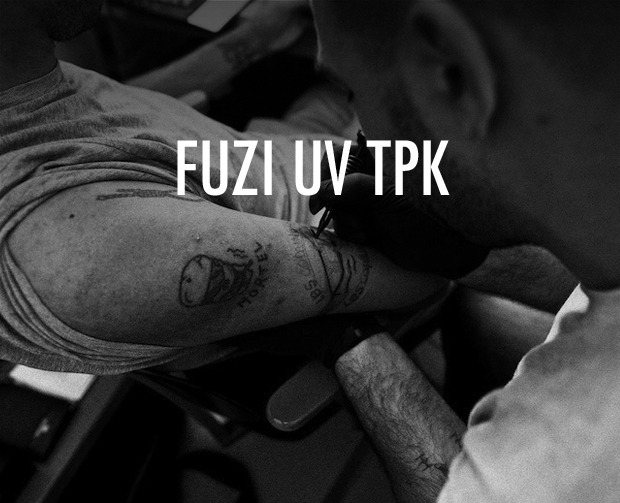

If Jeppe and Fergus are the undisputed ideologues of home tattooing, things are a little more complicated with Fusi UW TPC. His tattoos, of course, are boldly labeled "homemade" by all serious resources. But at the same time, there are reservations - Fusi has become a professional tattoo artist who charges money for his work, works with high-profile clients and is more or less recognized in the tattoo community.
Fusi's tattoos have been called weird, goofy and completely unique. But if you break it down, it turns out that he clearly follows the principles of home-made tattoos: simple design, working from home and pedaling the uniqueness of each tattoo.
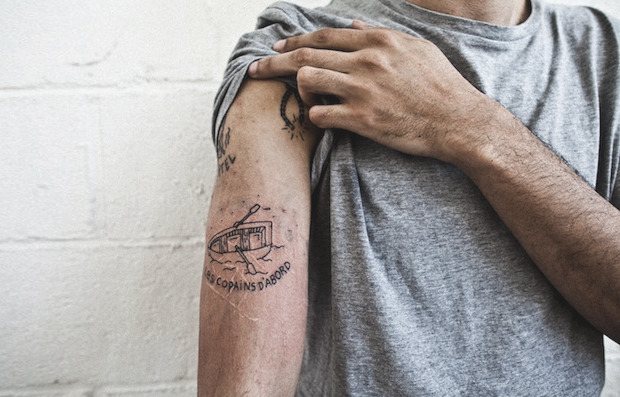

| Fuzi UV TPK., tattoo artist. | "I only do tattoos in my own style. No tribal - just Fuzi's original style. Most tattoo artists repeat the same pictures over and over again, consider themselves professionals and hold a secret technique. But I have my own rules - buy a machine, get started and don't follow the mainstream. I don't care how perfect the tattoo is, but I don't want a copy of what my neighbor has - a prison tattoo or a garage tattoo seems much cuter to me. |
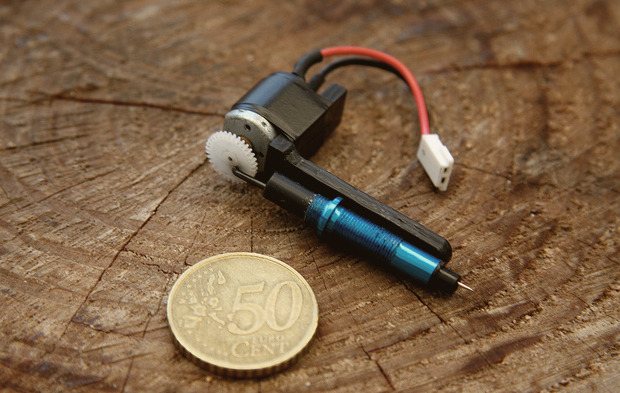

Examples of homemade tattoo machinesHomemade tattoo machine examplesHomemade tattoo machine examplesHomemade tattoo machine examplesHomemade tattoo machine examplesHomemade tattoo machine examplesHomemade tattoo machine examplesHomemade tattoo machine examples

